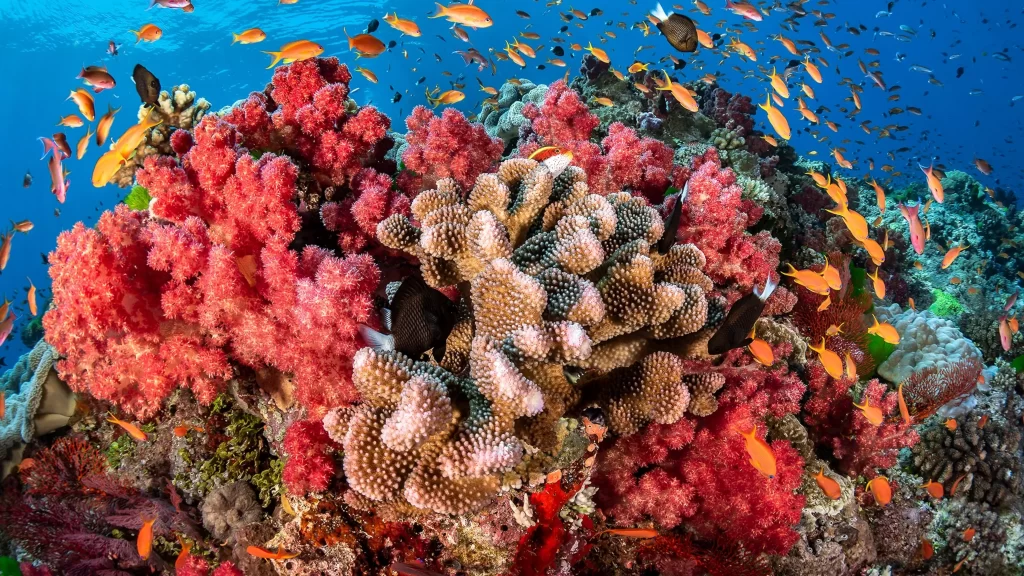What are Corals?
Corals are made up of genetically identical organisms called polyps.
These polyps have microscopic algae called zooxanthellae living within their tissues.The corals and algae have a mutualistic relationship.
- The coral provides the zooxanthellae with the compounds necessary for photosynthesis.
- In return, the zooxanthellae supply the coral with organic products of photosynthesis, like carbohydrates. These products are utilised by the coral polyps for synthesis of their calcium carbonate skeletons.
- In addition to providing corals with essential nutrients, zooxanthellae are responsible for the unique and beautiful colours of corals.
- They are also called the “rainforests of the seas”.
- There are 2 types of corals:
- Stony/Hard, shallow-water corals-the kind that build reefs.Hard corals, extract calcium carbonate (also found in limestone) from the seawater to build hard, white coral exoskeletons.
- Soft corals and deep-water coral- live in dark cold waters. Borrow their appearance from plants and attach themselves to skeletons.
- Soft corals also add their own skeletons to the hard structure over the years.
- The growing multiplying structures gradually form coral reefs.They are the largest living structures on the planet.

What is Coral Bleaching?
Coral bleaching refers to the whitening of coral reefs due to the expulsion of symbiotic algae (zooxanthellae) or the loss of pigmentation within the algae.
It occurs due to stress induced by changes in environmental conditions such as temperature, light, or nutrients.
This results in corals turning completely white.
Causes of Coral Bleaching
- Temperature Stress
- Elevated sea temperatures, particularly during prolonged periods of heatwaves, can disrupt the symbiotic relationship between corals and algae.
- El Niño events can elevate sea temperatures and lead to the destruction of coral reefs.
- Light Intensity
- Excessive sunlight, especially in combination with high temperatures, can lead to photoinhibition and damage to the photosynthetic machinery of algae.
- Reduced cloud cover and increased radiation can exacerbate coral bleaching.
- Pollution
- Runoff, chemicals, and sedimentation can further stress corals, making them more susceptible to bleaching.
- Ocean Acidification
- The escalation in carbon dioxide levels leads to greater absorption of carbon dioxide by the oceans, raising the acidity of ocean water and hampering the coral’s capacity to form calcium carbonate skeletons.
- Infectious Diseases
- Bacteria, such as Vibrio shiloi, can disrupt the photosynthesis process of zooxanthellae, and their effectiveness increases in higher sea temperatures.
- Elevated Sedimentation
- Deforestation and development along coastlines lead to increased erosion, resulting in a higher concentration of suspended sediment particles that can suffocate corals, diminish light penetration, and potentially hinder coral photosynthesis and growth.
Consequences of Coral Bleaching:
- Disruption of Food Chains: Alterations in coral communities can disrupt species reliant on them, such as fish and invertebrates that use live coral for sustenance and shelter. The loss of these marine creatures can disturb entire food chains.
- Loss of Biodiversity: Reductions in genetic and species diversity may occur with coral mortality from bleaching events.
- Economic Downturn: Vibrant coral reefs attract tourists, including divers. Bleached and degraded reefs may deter tourism, impacting local economies.
- Impact on Food Availability: Coral bleaching can prompt significant shifts in fish populations, potentially leading to decreased catches for fishermen and affecting food availability and associated economic activities.
- Coastal Protection Impacts: Coral reefs serve as natural barriers, absorbing wave energy and safeguarding coastal areas from storm damage, erosion, and flooding.
Mass Coral Bleaching:
- First Mass Bleaching: Occurred in 1998. due to El Niño weather pattern, resulting in the death of 8% of the world’s coral.
- Second Mass Bleaching: in 2002. The most severe events occurring from 2014 to 2017.
- Third Mass Bleaching: 2014 to 2017, affecting reefs in Guam, the Western Pacific region, and the North and South Pacific, and the Indian Ocean.
- During the 2014-17 event, over three times as many reefs experienced bleaching-level heat stress compared to 1998.
- A 2021 study by the Global Coral Reef Monitoring Network (GCRMN), backed by the United Nations, revealed that between 2009 and 2018, 14% of the world’s coral on reefs had been lost, with coral bleaching being the primary cause.

Steps to Protect Coral Reefs from bleaching:
- Implementing Solutions Across Boundaries: Addressing the future of coral reefs requires actions that transcend social, economic, and cultural barriers.
- Promoting Sustainable Practices: Encouraging sustainable fishing practices and fostering opportunities for ecotourism can contribute to coral conservation efforts.
- Reducing Chemical Pollution: Minimising the use of non-biodegradable chemicals such as fertilisers, insecticides, pesticides, and herbicides that harm corals is essential.
- Halting Unplanned Coastal Development: Stopping unregulated coastal development is crucial for reversing reef decline in certain areas.
- Addressing Climate Change: Taking comprehensive measures to combat global warming is imperative, as climate change poses the most significant threat to coral reef ecosystems.
- Proper Industrial Waste Management: Treating harmful industrial waste before disposal into water bodies is necessary to prevent pollution and coral damage.
- Preventing Water Pollution: Avoiding the dumping of chemicals or oils into water bodies whenever possible helps mitigate the impact of pollution on coral reefs.
Initiatives to Protect Coral Reefs:
- Various global initiatives are underway to tackle coral reef issues, including:
- International Coral Reef Initiative
- Global Coral Reef Monitoring Network (GCRMN)
- Global Coral Reef Alliance (GCRA)
- The Global Coral Reef R&D Accelerator Platform
- The Ministry of Environment, Forests, and Climate Change (MoEF&CC) in India has incorporated coral reef studies within the Coastal Zone Studies (CZS).
- In India, the Zoological Survey of India (ZSI), in collaboration with Gujarat’s forest department, is implementing coral reef restoration efforts using “biorock” or mineral accretion technology.
- The National Coastal Mission Programme aims to safeguard and maintain coral reefs in the country.

Leave a Reply
You must be logged in to post a comment.